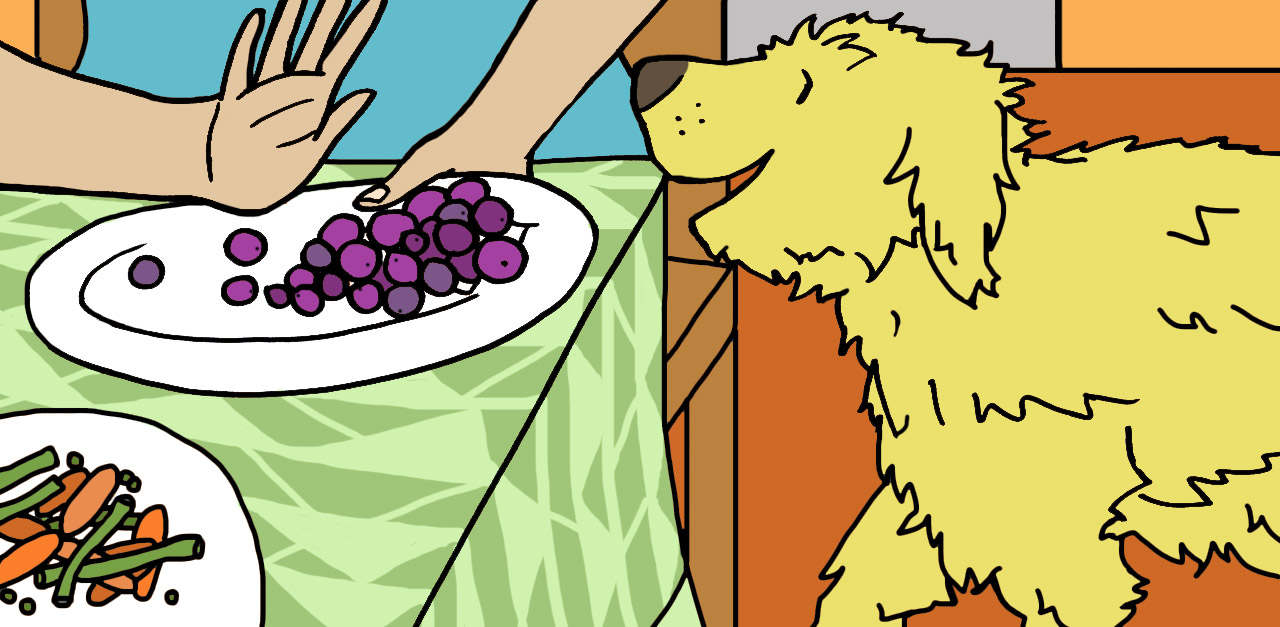

Treatment via an emergency veterinarian is always necessary to ensure that your dog has not been harmed from grape toxins. Always follow-up on all appointments, and keep a close eye on your dog while he or she is recovering at home.
Follow-up treatment is necessary to protect your dog’s kidneys. Your veterinarian may do a gastric lavage, and/ or administer activated charcoal to absorb the grape and raisin toxins. It’s important to note that this method can only be used twice and that your dog should be taken to an emergency veterinarian for treatment, and a check-up afterward. If your dog does not vomit within 15 minutes of the peroxide administration, veterinarians advise trying this out again with the same amount capped always at 45 ml, even if your dog weighs more than 45 pounds. Squirt the 3% peroxide into the back of your dog’s mouth using a syringe. That said, you cannot give a dog, regardless of weight, more than 45 ml of peroxide. Administer 3% or 1 milliliter (ml) peroxide per pound of your dog’s weight by using a syringe or teaspoon with the maximum amount being 45 ml. If you’ve called your veterinarian because your dog has already vomited after eating grapes or raisins, your veterinarian may recommend you to stay at home and do the following: Your veterinarian will then discuss other options with you. Yet, if your dog is not producing any urine, survival is not likely at this stage. Your dog will also be put on medications to stimulate increased urine production. Nonetheless, if your dog has eaten a large amount of either grapes or raisins, or if he or she is already vomiting or has diarrhea, your veterinarian will administer fluids for 48 hours to increase urine output. That said, dogs that have already vomited will still need to be taken to the emergency veterinarian for treatment. Dogs that show signs of a shock need to be taken to the emergency veterinarian right away. In addition, vomiting should not be induced in dogs that have lost consciousness or are having trouble breathing. Your veterinarian will then administer activated charcoal to absorb toxins. That said, vomiting is best induced within 15 to 20 minutes after your dog has eaten either grapes or raisins, regardless of how many grapes eaten. If your dog has eaten grapes or raisins in the past two hours you will need to induce vomiting. The diagnosis will be based on symptoms and the history of your dog’s exposure to grapes. This type of decontamination is efficient only if the decontamination occurred within the last two hours.You will need to take your dog to an emergency veterinarian if it’s after hours. Generally, the treatment plan includes:ĭecontamination – inducing emesis with 3 percent hydrogen peroxide (2ml/kg but no more than 45ml) followed by administering activated charcoal. /dog-and-grapes-133028936-582deaca3df78c6f6ae2245d.jpg)
The treatment is focused on elimination of the toxins, protecting the kidneys while the toxins are still in the circulation and alleviating the subsequent symptoms. Unfortunately, there is no specific antidote that can fully reverse the grape’s toxic effects.

Common differential diagnosis include poisoning with ethylene glycol and cholecalciferol. In the differential diagnosis, other causes of renal failure must be taken into consideration. The retained waste products accumulate in the dog’s body and lead to detrimental effects.

The term anuric renal failure describes kidney impairment that leads to inability to produce urine and excrete waste products. The ultimate effect, anuric renal failure, develops within 72 hours of indigestion. Symptoms of Grape/Raisin Toxicity in Dogsĭata collected from veterinary clinics show that dogs manifest initial signs of intoxication 6 to 12 hours after indigestion. This means there is no relationship between the amount of ingested fruit and the severity of the toxic reaction. The only scientifically backed-up data is that the toxicity is not necessarily dose-dependant. Unfortunately, the exact mechanism of grapes toxicity is not fully understood. However, it is safe to assume that dogs already suffering from kidney diseases are at higher risk of developing acute renal failure. There are currently no reported breed, age or gender predispositions to developing grape toxicity. On a per-weight basis, raisins are approximately 4.5 percent more concentrated than fresh grapes. On the flip side, in some dogs, only 2 to 3 pieces are enough to cause poisoning.



/dog-and-grapes-133028936-582deaca3df78c6f6ae2245d.jpg)




 0 kommentar(er)
0 kommentar(er)
